Chinese food is undoubtedly one of the most popular cuisines today, though often high in carbohydrates, fat, and sodium. It’s usually difficult to enjoy this food while on a diet, but we have identified several ways to do so.
Read on to discover the best Chinese foods to order on a diet and how to modify options within your meals to fit a healthier lifestyle. Is Chinese Food Healthy?
First things first: traditional Chinese cuisine is a pretty healthy choice. Classic dishes include lots of:
- Chicken
- Fish
- Herbs
- Brown rice
- Low-carb veggies:
- Broccoli
- Bok choy
- Mushrooms
These ingredients are common in traditional Chinese cooking and are overall healthy, nutritionally dense items. However, the Americanized version of these popular foods has gradually changed, making many traditional entrees nearly unrecognizable today.
This results in many popular go-to dishes with exceedingly high levels of carbohydrates, fat, and sodium. For example, an order of General Tso’s Chicken can tip the scales at:
- Around 1,500 calories
- Average of 80 g fat
- 128 g carbohydrates
- Over 2,000 mg sodium
This dish nearly exceeds your entire allotment of sodium for the day, over half of your recommended carbohydrates, accompanied by almost an entire days’ worth of calories, and well over the daily recommended fat intake (44-78 g on average).
Fortunately, there are many options available for health-conscious individuals to still enjoy their favorite meal at a Chinese restaurant.
12 Low Carb Chinese Food Options to Order on a Diet
Many people understand that battered and fried chicken or pork drenched in a sweet and sour sauce, heaped over a steaming pile of friend rice is hardly a diet-friendly meal.
Recognizing “bad” foods at face value is much easier than searching out a more nutrient-dense, diet-friendly option.
Luckily, we have compiled a list of twelve healthier options to order the next time you’re craving Chinese takeout. These popular entrees contain fewer carbohydrates and fat than many others on the menu, along with a sufficient level of protein.
(check it out: 25 best takeout food from Chinese Restaurants)
Depending on your specific dietary needs or guidelines, you may just find the perfect go-to dish!
#1. Beef and Broccoli is a Great Choice
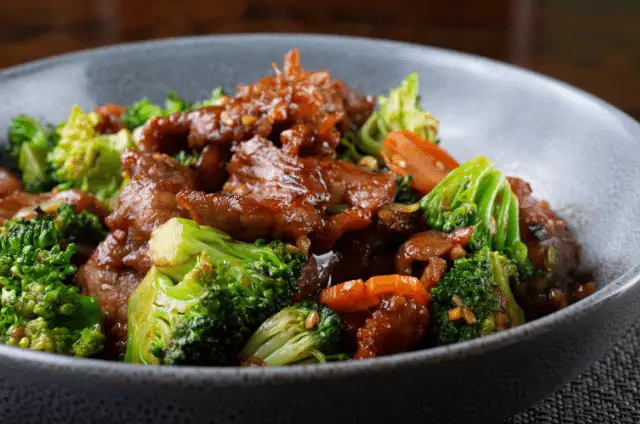
This dish originated in China as “Gai Lan Chao Niu Rou”. Gai Lan is Chinese broccoli, but as it was historically difficult to find this variety in the US, our familiar variety of broccoli became a quick stand-in.
What’s now commonly known as restaurant-style Beef and Broccoli is a great choice if you’re wanting to enjoy Chinese food while on a diet. It’s a simple, healthy meal with nutrient-rich veggies. This dish generally contains:
- Strips of beef
- Broccoli
- Occasionally sliced mushrooms or onions
- Sauce
You can personalize this dish by adding various vegetables; be sure to ask for the sauce on the side. It can be high in sugar and fat, so it’s best to have control of how much you are using.
This dish is light and low carb, with a 100g portion containing:
- 10.5 g protein
- 5.3 g carbohydrates
- 10.6 g fat
This dish is often served with rice, but substituting more fresh veggies or skipping the rice altogether will be beneficial.
#2. Mu Shu Lettuce Wraps are Fresh and Light

Mu Shu lettuce wraps are a crisp and refreshing take on traditional Chinese food, originating in northern China and brought to the US in the mid-1900s, where it has developed into the dish we know today.
These are often ground pork or chicken but can also be tofu or beef. The filling contains bits of different sauteed veggies like cabbage and mushrooms wrapped in a crisp leaf of butter lettuce or romaine lettuce.
They are often topped with crushed cashews or wonton strips for a crunch and served with hoisin or plum sauce for dipping. Again, watch the amount of these sweet sauces that you are ingesting.
Cashew toppings win out here over wonton strips, adding protein and healthy fat instead of empty carbs.
A portion of 100g Mu Shu lettuce wraps contains, on average:
- 13.9 g protein
- 12 g carbohydrates
- 15 g fat
Luckily, Mu Shu lettuce wraps rarely come with rice or other carbohydrate-rich sides, so you shouldn’t need to substitute much with this dish.
#3. Egg Foo Yung is Like an Omelet

Egg Foo Yung is another diet-friendly choice when eating Chinese food. This dish was likely developed in Shanghai in the mid-1800s, where similar recipes still exist today.
This is the Chinese version of (or slightly comparable to) an American egg omelet. This meal can be eaten at any time of day but generally is a dinner entrée. There is a lot of crispy texture in this dish, containing:
- Egg
- Bean sprouts
- Water chestnuts
- Green onions
- Cabbage
- Mushrooms
The dish is commonly served with a spicy gravy-like soy sauce drizzled over the top and may or may not contain shrimp or pork. It is usually served on a bed of steamed or fried rice. To decrease your carbs even further, ask for more veggies instead. Again, requesting the sauce on the side will provide more control over your carbohydrate and calorie consumption.
Egg Foo Yung, per 100g serving, generally contains:
- 9.2 g protein
- 3 g carbohydrates
- 10.3 g fat
#4. Moo Goo Gai Pan is a Simple Dish
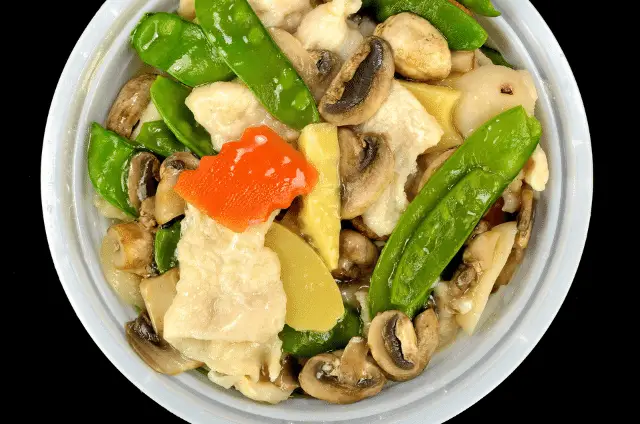
This dish translates to “Mushroom Chicken Slices” and is a vegetable-heavy stir fry dish that is low in carbs and high in nutrients. It began as a Cantonese recipe but has slowly transitioned into the recognizable American Chinese dish today.
Restaurant-style Moo Goo Gai Pan usually contains:
- Chicken
- Mushrooms
- Bamboo shoots
- Broccoli
- Water chestnuts
- Peas
All of these ingredients are sauteed and topped with a soy and oyster sauce, sometimes thickened with cornstarch. Nothing in this dish is deep-fried or mixed with noodles or rice, so it is one of the lowest carb dishes you’ll find at a Chinese restaurant.
A 100-gram portion of Moo Goo Gai Pan generally contains:
- 9 g protein
- 5.5 g carbohydrates
- 3 g fat
To increase your protein intake with this dish, try adding a little extra chicken, tofu, or some shrimp.
#5. Peking Duck is a Famous Dish
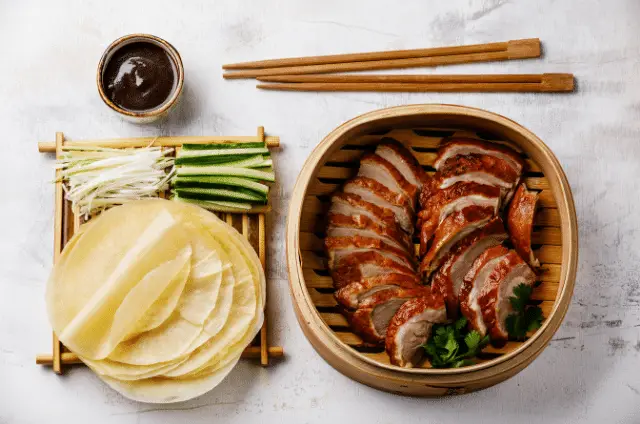
Peking duck is a well-known and popular dish served at many Chinese restaurants. This dish originated in the Mongol Empire in China, where cooks perfected the complicated cooking procedure for the emperor. Some chefs were even raised to the rank of “minister” because of their culinary feats.
The duck is often steamed and then roasted. Often this dish must be ordered a full day or more in advance due to the extended process of roasting and basting that goes into the traditional dish. If you have your heart set on this dish, it’s best to call ahead and ask about timing.
Peking Duck is a sweet and savory dish packed full of herbs and spices, including:
- Honey
- Parsley
- Nutmeg
- Cinnamon
- Cloves
- Ginger
Due to the basting process, this dish is somewhat higher in fat and carbs and has a high protein content. Peking Duck is commonly served with soybean paste (hoisin sauce) or plum jam, and a variety of fresh sliced vegetables like cucumber and onion, all wrapped in a thin pancake.
Skipping this last step and eating it without wrapping will further decrease your carbohydrate count.
A 100-gram portion of Peking Duck with sauce has, on average:
- 12 g protein
- 16 g carbohydrates
- 16 g fat
As is common with Chinee cuisine, the sauce contains a high level of sugar and fat. To enjoy this dish to the fullest without overloading on sugar, you can thin the sauce with some soy sauce or rice vinegar to make it go further.
#6. Buddha’s Delight is a Great Vegetarian Choice
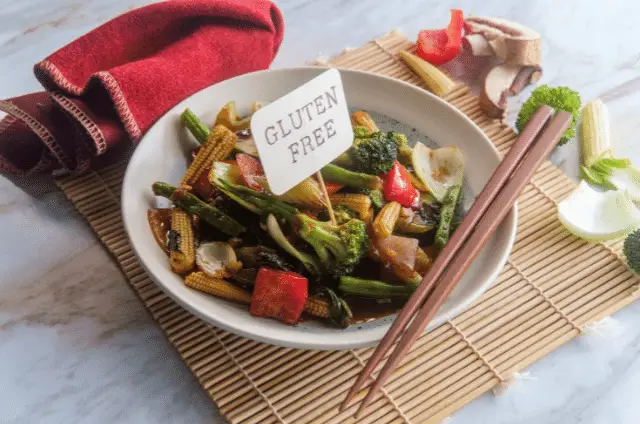
Buddha’s Delight is a well-known vegetarian stir fry dish often served in Chinese cuisine, with roots in the Buddhist culture, as vegetarian monks were known to partake in this dish often.
Buddha’s Delight is colorful and nutritionally dense, coated with a light sauce and served over rice. This dish often contains:
- Tofu
- Ginger
- Sesame
- Baby corn
- Bamboo shoots
- Broccoli
- Mushrooms
Skipping the rice or noodle portion of this dish will further decrease the number of carbohydrates in the meal. The sauce is light, containing just soy sauce, ginger, sesame oil and honey, so it is best served on the side but will not break your diet if you forget.
A serving of 100 g of Buddha’s Delight contains roughly:
- 4.5 g protein
- 8.5 g carbohydrates
- 6 g fat
Other more exotic ingredients used in this dish can include:
- Bamboo fungus
- Bean curd stick
- Daylily buds
- Wood ear (black fungus)
Due to the wide variety of vegetables and fungi found in this dish, it’s easy to substitute and accommodate many different preferences.
#7. Steamed Dumplings are a Lighter Choice
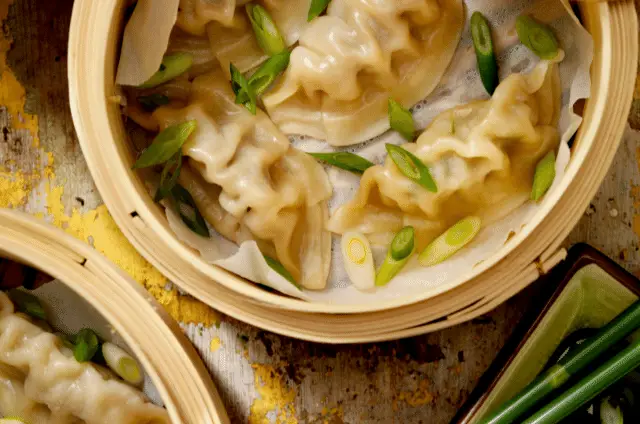
These popular appetizers are found at most restaurants serving Chinese or Asian food. Dumplings are simply dough cooked around a filling, and there are variations of this food in most cuisines. Empanadas, ravioli, and pierogis are all dumplings in their own right.
Chinese steamed dumplings are often filled with:
- Ground pork or chicken
- Chives
- Ginger
- Occasionally sliced carrots or cabbage
The dumplings are steamed, some may be pan-fried (steamed is healthiest). Many times, the dumplings will come with either a hoisin dipping sauce or a sweet and sour sauce. We recommend simplifying your sugar and calorie intake by eating them without sauce, or, if you must, a small amount of soy sauce.
Dumplings are one of the healthier options at a Chinese restaurant, particularly in the appetizer section. In a 100 g serving of dumplings, you will get:
- 11.5 g protein
- 9.5 g carbohydrates
- 2.6 g fat
Dumplings aren’t generally made to order, rather in a large batch, so customizing them can be tricky. Luckily, they are generally a low-carb, high protein dish all on their own.
#8. Spring Rolls are Well-Known and Widely Available
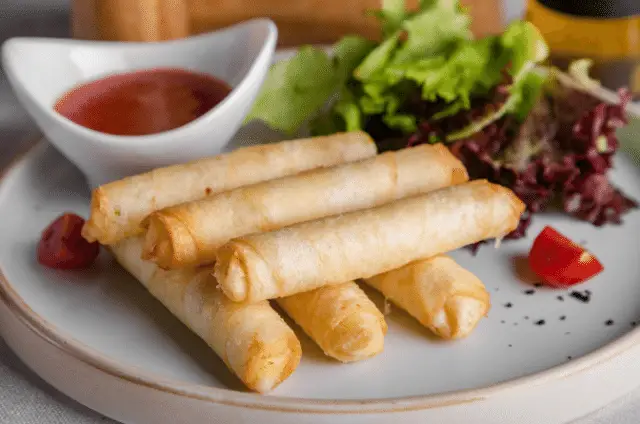
Spring rolls are an intensely popular appetizer dish at Chinese American restaurants. Spring rolls originated in China, where crisp and fresh veggies were rolled into a small, thin pancake and enjoyed in the springtime after a long, cold winter.
This fresh and refreshing style has been generally maintained today. Current versions of spring rolls are usually a fried or steamed roll of meat and veggies wrapped in a wonton or rice paper. Most spring rolls contain:
- Ground pork
- Mushroom
- Carrot
- Cabbage
These rolls are often served with spicy mustard or a sweet and sour sauce. Be mindful of the sauce amount used when dipping, as many have hidden sugar and carbohydrates that will sink this diet-friendly meal.
A serving of 100 g of spring rolls without sauce (roughly one and a half spring rolls) will have:
- 5.6 g protein
- 20 g carbohydrates*
- 9 g fat
*many restaurants offer their spring rolls in cabbage (or other leafy options) and not solely wonton wrappers. This carbohydrate count is assuming the wonton wrappers were used. Cabbage or other vegetable wrappers will drop the carbohydrate count by 50% or more.
#9. Happy Family Blends Many Ingredients
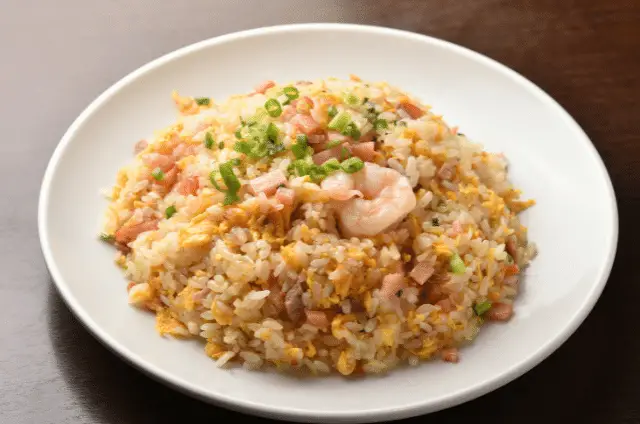
This low-carb dish is a favorite for the vast array of ingredients available. Happy Family got its name from the supposed ability of each ingredient to compliment the others, despite being a variety of foods in one dish.
That variety also means that Happy Family is highly customizable to your dietary needs. Happy Family is extremely popular, found at the majority of Chinese restaurants under the “Chef’s Special” section, and often contains:
- A variety of vegetables (carrots, broccoli, mushroom, baby corn, bamboo shoots)
- Choice of one or more meat (pork, chicken, beef)
- Choice of one or more seafood (shrimp, lobster, crab, scallops)
These ingredients are sauteed together and drizzled with a light brown soy and oyster sauce. This dish generally does not come with rice or noodles, so it is automatically a low carb choice. Watching the amount of sauce, or getting it on the side, will further deduct from your carb/calorie count.
For a 100g serving, you can expect:
- 26 g protein
- 11 g carbohydrates
- 15 g fat
The sauce is mostly soy sauce, broth, and sugar, which provides a smooth, savory sauce that lends itself well to the blend of different flavors.
#10. Mandarin Tea Eggs Have an Exciting and Interesting Design
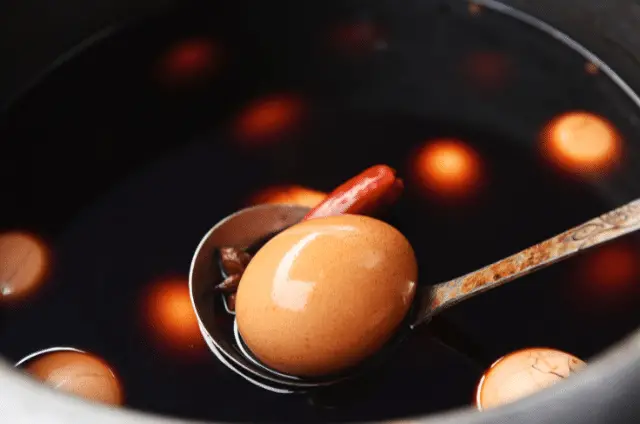
Mandarin Tea Eggs (also known as Chinese Boiled Tea Eggs) is a fun, creative dish. They originated in China as a way to preserve fresh eggs but are now commonly eaten as street food all around the world.
These are often a snack, so work well as an appetizer or a light dinner option. These eggs are boiled, then the shells are cracked, and before being peeled, they are boiled again in tea or spices which flavor the eggs. This gives the eggs a fun crackle color on the inside.
A 100 g serving (about 2 average-sized chicken eggs) will provide:
- 1.1 g carbohydrates
- 12.4 g protein
- 10 g fat
There is not much to worry about customizing or substituting with this dish, as it generally is served on its own.
#11. Chop Suey Isn’t Actually from China
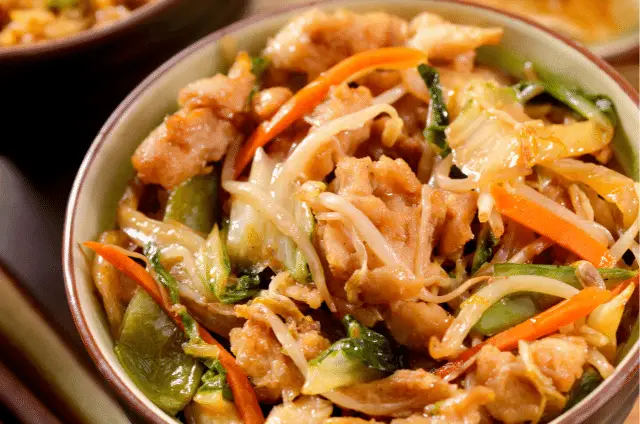
Chop Suey is a well-known, well-loved Chinese dish. Many believe that this dish wasn’t invented in China, but in New York City, a visiting Chinese Ambassador made it for his guests.
Chop Suey is packed full of nutritious veggies, topped with a sweet and savory sauce, and you can expect to see a variety of ingredients including:
- Celery
- Pork tenderloin (or chicken)
- Onion
- Bell peppers
- Mushrooms
- Peas
Often this dish incorporates a lot of American vegetables, as is tradition, but bamboo shoots or bean sprouts are a common addition. Again, with this dish, ask for the sauce on the side to benefit your diet.
This dish is low in carbs and fat, with a healthy amount of protein. In a 100 g serving, you will get:
- 4.5 g carbohydrates
- 8 g protein
- 3.9 g fat
This dish is most often served with rice, so skipping that altogether or substituting with either more veggies or cauliflower rice will benefit your diet.
#12. Kung Pao Chicken Has a Kick
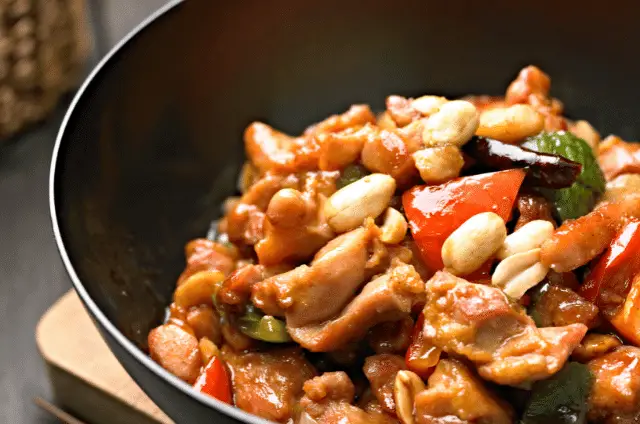
Kung Pao Chicken is one of the most popular dishes in American Chinese cuisine, known for its spice. You’ll be hard-pressed to find a Chinese restaurant without this dish on the menu. It originated in the Sichuan (Szechuan) province of China but has transformed and been “westernized” quite a bit to become the dish many recognize today.
This dish is a spicy stir fry, often containing:
- Szechuan peppercorns
- Tien Tsin (also known as Chinese Red Peppers)
- Bell peppers
- Onion
- Mushroom
- Chicken
This dish is easily recognizable by the little, often dried, red chili peppers in the dish. If you’ve ever bitten into one, you know that they pack a lot of heat. These peppers aren’t meant to be ingested, instead, they infuse the dish with spice and add color.
As long as the rice or noodles are skipped, this dish is a good choice for those on a low-carb diet. In 100 g of this dish, you’ll find:
- 6.9 g carbohydrates
- 9.8 g protein
- 7 g fat
The sauce on Kung Pao chicken is a strong, broth-based chili pepper sauce. Often the chicken is marinated in the same liquid. This provides a rich, intense flavor throughout the dish.
Try this meal with the sauce on the side, you’ll still get the flavor from the marinade, but the sugar and starch won’t ruin your healthy choice.
Chinese Foods to Avoid on a Diet
If none of the above meals pique your interest, we have several other options for customizing healthier Chinese food meals. First of all, knowing which high-carb ingredients are lurking in your dish can help you avoid them and make a healthier choice.
Items to avoid when eating a low-carb diet include:
- Noodles
- Rice
- Breaded meats
- Fried items
- Sugary Sauces
Why You Should Avoid Noodles on a Diet
Noodles are a carbohydrate paradise. They are a filling, often affordable choice to beef up the size of your plate at a Chinese restaurant. Some brands may be fortified with added nutrients, but most of the time, they don’t offer much more than a heavy filler.
Avoid noodles in your dishes if possible, bonus points for substituting veggie noodles (zucchini noodles are a common option) or a mix of sauteed veggies instead.
Why Rice Should Be Avoided When Dieting

Sides of rice, much like noodles, carry a high level of carbohydrates. This is another cheap filler to enhance the size (and profit margin) of your meal at a restaurant. Steamed brown rice provides more nutrients and fewer carbs if you just can’t bring yourself to skip the rice.
Treat rice accompanying your meal much like noodles; substitute for veggies when possible, and enjoy reduced carb count at dinner.
Avoiding Breaded Meats on a Diet
Breaded and fried meats are among the most popular Chinese dishes; think sweet and sour pork or a big bowl of General Tso’s chicken. These are a highly Americanized development and have increased the carb content of many dishes.
An easy swap to reduce your carb intake when on a diet and still enjoy Chinese food is to switch out that fried pork for some sauteed chicken or steamed fish. You can even ask for the same meat with sauteed or baked instead of breaded and fried. Many restaurants have both options available.
Healthy Modification Options for Chinese Food
Avoiding some of the most popular dishes at your favorite Chinese restaurant may sound like a drag. Luckily, there are healthy options available to fit your dietary needs and customize your favorite meal, and they can be just as delicious!
With minor adjustments and modifications, you can choose a meal that sits within your dietary guidelines, and you won’t have to use your “cheat meal” when enjoying these dishes.
Don’t be afraid to ask for modifications at any restaurant. Many restaurants, Chinese and otherwise, make your food to order, so customizing spice level and ingredients are just the simple matter of asking.
Choosing a Healthier Sauce for your Chinese Food
One of the surprisingly unhealthy culprits in many Chinese dishes is the sauce that coats your meal. Many of these sauces can contain high levels of added sugars, carbohydrates, and fats. Some of the worst choices while on a diet include:
- General Tso’s
- Sweet and Sour
- Plum Sauce
There are healthier options available. Try swapping out one of the sauces listed above at your next meal for one of these healthier, lower-carb choices:
- Buddha Sauce
- Brown Sauce
- Chinese Hot Mustard
A general rule of thumb is this: the darker and thicker a sauce is, the higher sugar and calorie count. Switch out your sauce for a lighter option or at least ask for it on the side so you can limit your intake.
Swap Out Main Ingredients for a Healthier Option
Another more obvious culprit for adding unnecessary carbs is the main ingredient of your chosen dish. Most often, these are the meats that accompany the sauces and veggies in your meal.
As mentioned above, if there is an option to switch out fried beef or pork for a leaner, non-breaded meat like baked chicken or steamed fish, that would go along way in making your meal more diet-friendly.
Fish and chicken are much leaner meats and contain less fat and calories than the same sized portion of beef or pork. For example:
| Meat (per 100 g or 3.5 oz) | Fat (grams) | Calories |
| Pork | 14 | 270 |
| Beef | 11.8 | 217 |
| Chicken | 3.6 | 165 |
| Fish (ex. tilapia) | 1.9 | 84 |
Many health sites recommend chicken and fish as your go-to meat and cutting back on red meats (beef and pork) to once or twice a week.
Choosing a Healthier Side to Accompany your Entrée
Rather than the usual side of fried white rice, which adds many carbs and little nutritional value, you may ask to substitute another dish. Try asking for:
- Sauteed vegetables
- Steamed vegetables
- Steamed brown rice
- Cauliflower rice
- Soup
Clear soups like Egg Drop Soup or Hot and Sour Soup are much lower in carbohydrates and are better for your waistline than a scoop of rice soaked in soy sauce, or an egg roll dipped in a sweet and sour sauce.
These savory soups are readily available at all Chinese restaurants, and often can be substituted for no charge.
Ask for your dumpling or other appetizers to be steamed rather than fried. Cutting down on the amount of oil used to prepare your meal is one of the easiest and most diet-friendly methods to maintain your improved eating.
Many restaurants already have an array of vegetables available throughout their menu, so picking and choosing your favorites is an easy way to customize your meal to something healthier that you know you will still enjoy.
Cauliflower rice is becoming a more popular option across all cuisines. Take advantage of this opportunity if you can, as one cup of cauliflower rice contains 3-5 grams of carbohydrates, while one cup of rice contains nearly 45 grams.
The Importance of a Balanced Diet
When dieting, it’s important to develop a sustainable and enjoyable routine. You are much more likely to stick to your plan if you are also enjoying it.
Cutting out carbohydrates, excessive fat, and added sugars are sure to provide beneficial changes to your health.
Moderation is also key to developing a healthier lifestyle. You are much more likely to see results if you are able to maintain your routine, like by enjoying dishes that you’ve always loved.
Hopefully, this article sheds some light on the available options for enjoying your favorite Chinese dishes in a healthier manner while on a diet.
